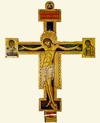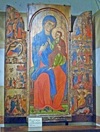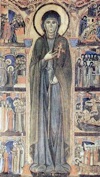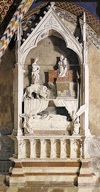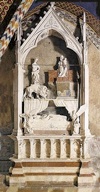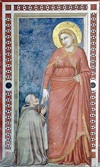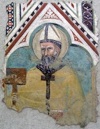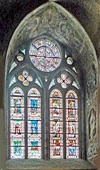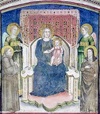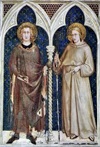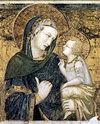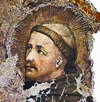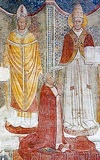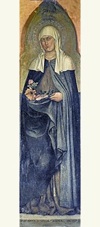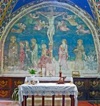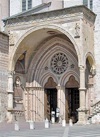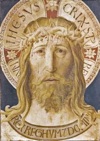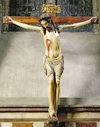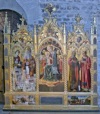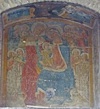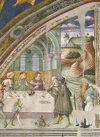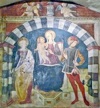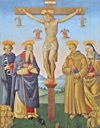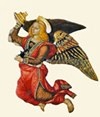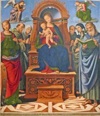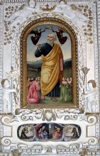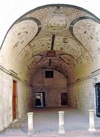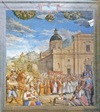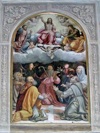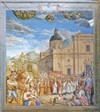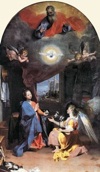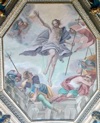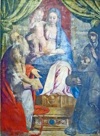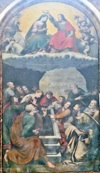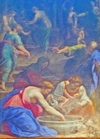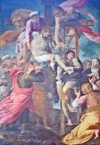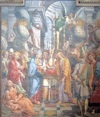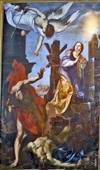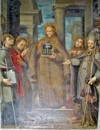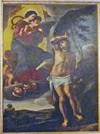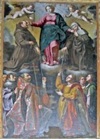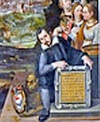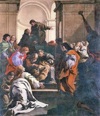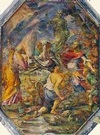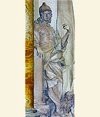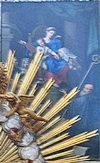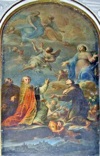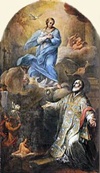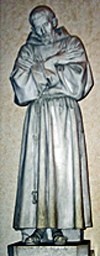

Giunta Pisano (ca. 1180-1260)
This crucifix (ca. 1236) from Santa Maria degli Angeli bears the signature of Giunta Pisano ([IUN]TA PISANUS [CAP]ITINI). It depicts the dying Christ in agony (Christus patiens), an iconography that was already established in Byzantine art but was new to Italy. Giunta Pisano also signed a similar crucifix from the Upper Church of San Francesco that was destroyed in ca. 1700. The documented inscription also recorded that Brother Elias had commissioned it in 1236.
Rainaldo di Ranuccio (13th century)
Rainaldo di Ranuccio is known from two signed crucifixes, one of which is dated 1265. This historiated triptych (ca. 1270) in the crypt of Santa Chiara, which depicts the Madonna and Child enthroned and (on the inner surface of the doors) scenes from the life of Christ, is attributed to him
Maestro di San Francesco (died after ca. 1280)
The Maestro di San Francesco is named for a panel (ca. 1255) of St Francis in the Museo della Portiuncula, Assisi (a detail of which is illustrated here). All the works that have been attributed to him were executed for either San Francesco, Assisi or San Francesco al Prato, Perugia. This master was one of the first Italians to learn the art of working in stained glass, a skill he acquired in order to work on the windows in the upper church of San Francesco, Assisi.
Maestro di Santa Chiara (late 13th century)
The Maestro di Santa Chiara is named for the Santa Chiara Dossal (ca. 1283) in Santa Chiara (illustrated here). Two other works in Assisi are also attributed to him:
-
✴a crucifix (ca. 1260) that the Abbess Benedetta commissioned for Santa Chiara; and
-
✴frescoes (late 13th century) that were rediscovered in the Cappella della Madonna del Pianto of San Rufino in 1894, which are now in the Museo Diocesano.
Cimabue (died after ca. 1302)
A number of frescoes in San Francesco are attributed to the Florentine Cimabue, including:
-
✴the Maestà with St Francis (ca. 1275) in the Lower Church (illustrated here); and
-
✴a number of badly deteriorated frescoes (ca. 1278) in the apse and transepts and in the vaults of the crossing of the Upper Church.
Ramo di Paganello (died after 1314)
Ramo di Paganello was documented in his native city in 1281, when he returned from exile in France. No signed or securely documented examples of his work are known. He seems to have been capomaestro at the Duomo, Orvieto in ca. 1302-10, and subsequently to have worked at the Angevin court of Naples. The so-called Monument of the Emperor of Constantinople (ca. 1300) in the Lower Church of San Francesco Assisi (illustrated here) is attributed to him and/or to his associate, Rubeus (below).
Rubeus (late 13th/ early 14th century)
Two important bronze sculptures in Umbria are signed by a man called Rubeus:
-
✴the bronze upper basin (1277) of the Fontana Maggiore, Perugia; and
-
✴the bronze architrave (late 13th century) of the Porta di Postierla of the Duomo, Orvieto.
The Monument of the Emperor of Constantinople (late 13th century) in the Lower Church of San Francesco has been attributed to him and/or to his associate, Ramo di Paganello (above).
Giotto (died ca. 1337)
It seems to be beyond doubt that Giotto painted frescoes in San Francesco, but these probably did not include those in the Upper Church that were once attributed to him. He and his workshop seem to have worked in the Lower Church in two separate campaigns:
-
✴Phase I, which involved the Cappella di San Nicolò and the upper part of its entrance wall, began shortly before 1297.
-
✴Phase II, which involved the rest of the right transept, the apse and vaults above crossing and the Cappella di Santa Maria Maddalena probably followed in ca. 1309. The fresco illustrated here is from the Cappella di Santa Maria Maddalena.
Maestro Espressionista di Santa Chiara/ Palmerino di Guido (early 14th century)
This follower of Giotto is named for the frescoes in the right transept of Santa Chiara. This detail of his fresco of the funeral of St Clare there typifies his characteristically expressive style.
Maestro di San Crispino (ca. 1330)
Probably from Umbria
Giovanni di Bonino (died after 1345)
All of the surviving documents relating to “Maestro Giovanni di Bonino di Assisi” relate to work carried out on the stained glass and mosaics of the Duomo of Orvieto. The stained glass (14th century) windows in a number of chapels of the Lower Church of San Francesco are attributed to him. These include the windows (ca. 1316) of the Cappella di Sant’ Antonio da Padova, Illustrated here.
Origins unknown
This artist, who is named for a panel that is now in the Collegiata of Figline Valdarno, near Florence, seems to have worked in the workshop of Giotto (above) in Florence and Assisi in the early 14th century. Works in Assisi that are attributed to him include:
-
✴a fresco of the Madonna and Child with SS Francis and Clare in the sacristy of the Lower Church of San Francesco (illustrated here); and
-
✴the surviving fragment of a fresco of the stigmatisation of St Francis in the rural church of Santa Maria della Rocchicciola (Santa Maria in Arce).
Simone Martini (died after ca. 1344)
The frescoes (ca. 1317) attributed to the Sienese Simone Martini in the Lower Church of San Francesco include:
-
✴those in the Cappella di San Martino; and
-
✴those above and to the side of the Altare di Sant’ Elisabetta, in the right transept
The fresco illustrated here. which is from the Cappella di San Martino, depicts SS Louis IX of France and Louis of Toulouse.
Pietro Lorenzetti (died 1348)
Most of the frescoes (ca. 1317) in the Lower Church of San Francesco that are attributed to the Sienese Pietro Lorenzetti are in:
-
✴the Cappella di San Giovanni Battista; and
-
✴the left transept.
The detail illustrated here is from a frescoed altarpiece that was above the Altare di San Giovanni Evangelista in the left transept.
Puccio Capanna (died after 1350)
Puccio Capanna was probably a local artist who trained in Giotto’s workshop at San Francesco, Assisi. His only documented works are dated 1341, but a number of other works in Assisi from the late 1330s and the 1340s are attributed to him.
Pace di Bartolo (died after 1367)
This artist was documented in Assisi in the period 1344-67. A few of his documented works survive there, and others are attributed to him. These include a series of frescoes in the Cappella di San Giorgio of Santa Chiara, including this one in which St George saves a princess from a dragon.
Andrea de’ Bartoli (died after 1368)
This artist seems to enjoyed the patronage of Cardinal Albornoz in Bologna in the 1360s. In 1368, the heirs of Cardinal Albornoz commissioned frescoes from him for the Capella di Santa Caterina in the Lower Church of San Francesco, the chapel in which Cardinal Albornoz had been buried a year earlier. These frescoes include a depiction of Cardinal Albornoz laying his cardinal’s hat at the feet of Pope Clement VI, who had created him Cardinal Priest of San Clemente in 1350.
Matteo di Giovannello, il Gattapone (died after 1374)
From Gubbio
In 1367, the heirs of Cardinal Gil Albornoz paid il Gattapone for the repair of the Cappella di Santa Caterina, in which the cardinal was temporarily buried. Cardinal Albornoz made a bequest for the reconstruction of the infirmary in the west wing of the Sacro Convento di San Francesco, and the management of this project is also attributed to il Gattapone.
[Temporary link to Matteo di Giovannello, il Gattapone]
Ugolino di Montemarte (1325-88)
Ugolino di Petruccio da Corbara, Conte di Montemarte, entered the service of Cardinal Gil Albornoz in 1353 and remained in papal service for the rest of his life. He was primarily a soldier and administrator, but he also became expert in military fortifications. The design of the fortresses of Assisi (1362-5), which Cardinal Albornoz rebuilt after he had regained the city for the papacy, is generally credited to Ugolino di Montemarte.
Cola Petruccioli (died 1401)
Cola Petruccioli was documented in Assisi in 1394. This signed fresco of the Madonna and Child with saints in an exterior aedicule at the Oratorio di San Lorenzo was probably painted at this time..
Taddeo di Bartolo (died 1422)
Taddeo di Bartolo, who worked mostly in Tuscany, was also recorded in Perugia in 1403. His most important commission here was a signed polyptych for the high altar of San Francesco al Prato. Most of its panels are in the Galleria Nazionale, Perugia. This one, which depicts St Elizabeth of Hungary, is in the Perkins Collection in the Museo del Tesoro di San Francesco, Assisi.
Giovanni di Corraduccio Mazzaforte (died after 1437)
This large fresco (15th century) of the Crucifixion with saints in the lunette on the altar wall of the Oratorio di San Francesco is attributed to Giovanni di Corraduccio. St Mary Magdalene kneels at the foot of the Cross, with SS John the Evangelist and Francis on the right and the Virgin and other grieving women with St Leonard on the left.
Ottaviano Nelli (1375 - ca. 1450)
A number of works by or attributed to Ottaviano Nelli survive in his native Gubbio. This fresco (1422) of the Maestà with saints in the narthex of the Lower Church of San Francesco is attributed to him. So too is another fresco that he probably painted at about this time for the Ospedale dei Pellegrini, which is now in the Pinacoteca. It depicts the Madonna and Child enthroned with SS James and Antony Abbot and kneeling donors.
Neri di Monte (died after 1488)
Panels from stained glass windows in Perugia and Foligno, which were subsequently used in San Francesco, Assisi, are now in the Museo del Tesoro di San Francesco:
-
✴panels (ca. 1484) from the Cappella di Sant‘ Onofrio in the Duomo of Perugia , which are attributed to Neri di Monte; and
-
✴the panels (1485-8) from the tribune of the Duomo of Foligno, which are documented as his work.
A detail from the figure of St Felician from Foligno is illustrated here.
Francesco da Pietrasanta (died 1494)
This architect designed the porch (1486-7) that the Minister General Francesco Nani commissioned for the entrance to the Lower Church of San Francesco.
Benozzo Gozzoli (1420-97)
A small devotional image (ca. 1460) of the head of Christ crowned with thorns, which was documented in 1600 in the sacristy of the Lower Church, San Francesco, is now in the Museo del Tesoro there. It is executed in ink and tempera on parchment and mounted on a panel. It is attributed to Benozzo Gozzoli, principally on the grounds that a similar image (ca. 1450) is attributed to Fra Angelico, with whom he trained.
Giovanni Tedesco (late 15th century)
A crucifix (late 15th century) that is now in the Cappella di Santa Caterina of the Lower Church of San Francesco (illustrated here) is attributed to Giovanni Tedesco. The figure of Christ can be detached from the cross, and was probably taken in procession on Good Fridays.
[Crucifix in Santa Maria degli Angeli].
Nicolò di Liberatore, l' Alunno (1430-1502)
Nicolò di Liberatore was perhaps the most important participant in the vibrant artistic milieu of Foligno in the 15th century. Work by or attributed to him in Assisi include:
-
✴the signed San Rufino Polyptych (1462), which is now in the Museo Diocesano (illustrated here); and
-
✴four processional banners:
-
•two banners (ca. 1462) from the Oratorio di San Crispino, one that is now in the Pinacoteca Comunale and another in the Musée du Petit Palais, Avignon;
-
•a banner (1468) from the Oratorio di San Gregorio that is now Staatliche Kunsthalle, Karlsruhe; and
-
•the so-called Gonfalone della Peste (ca. 1470) for the Confraternita di served as the altarpiece Cappella di San Ludovico in the Lower Church of San Francesco in the 16th century and is now in the Priesterhaus, Kevelaer (in northern Germany).
A documented fresco (1492) of the Granting of the Portiuncula Indulgence on the facade of the chapel of the Portiuncula was over-painted in 1639.
Pietro di Giovanni Mazzaforte (died after 1502)
From Foligno
Text
[Temporary link to Pietro di Giovanni Mazzaforte]
Cristoforo di Jacopo (died after 1502)
This damaged fresco (15th century) above the entrance to the nunnery of San Quirico is attributed to Cristoforo di Jacopo. It depicts the Madonna and Child enthroned, with SS Francis and Quiricus.
Pierantonio Mezzastris (died ca. 1506)
The most extensive work in Assisi by Pierantonio Mezzastris is the documented cycle of frescoes (1477) in the Oratorio dei Pellegrini, one of which is illustrated here. Frescoes in two Observant Franciscan convents in Assisi are attributed to him:
-
✴a Maestà from Santa Maria degli Angeli, which is now in the Museo della Portiuncula; and
-
✴a Crucifixion in the choir behind the apse of San Damiano.
Matteo da Gualdo (died 1507)
Works in Assisi by or attributed to Matteo da Gualdo include:
-
✴a signed altarpiece (ca. 1468) of the Madonna and Child with saints from San Pietro, which is now in the Museo di san Pietro;
-
✴frescoes (1468) on the altar wall of the Oratorio dei Pellegrini;
-
✴two works in the Museo Diocesano
-
✴works in Museo Diocesano (attributed):
-
•three frescoes fragments(ca. 1470) from a niche in a house that was used by the Confraternita del Sacramento; and
-
• a triptych (ca. 1475) from the church of Santa Maria delle Grazie in the Castello di Palazzo (outside Assisi); and
-
✴ a fresco (1475) of the Madonna and Child with saints in San Paolo (attributed, illustrated here).
Bartolomeo Caporali (died after 1505)
From Perugia
Three frescoes in the rural church of Santa Maria della Rocchicciola (Santa Maria in Arce), one of which is dated 1487, are attributed to Bartolomeo Caporali.
[Temporary link to Bartolomeo Caporali]
Andrea d' Assisi, l’ Ingegno (died 1520)
Although this artist from Assisi is relatively well documented, no securely attributed works of his are known. This poorly preserved fresco (ca. 1500) of the Madonna and Child came from Porta San Giacomo and is now in the Pinacoteca Comunale. It was first documented in 1859, with an attribution to Andrea d’ Assisi, and is fundamental to any attempt to assemble a catalogue of his surviving works. The other works attributed him in Assisi and elsewhere in Umbria are described in the page devoted to him.
Tiberio d’ Assisi (ca. 1465-1524)
Tiberio d’ Assisi is well-documented in his native city, and a number of works there are attributed to him. The most important of these are:
-
✴an altarpiece (ca. 1509) of the Crucifixion with saints from the Cappella di Sant' Antonio Abate in the lower church of San Francesco, which is now in the Museo del Tesoro (illustrated here);
-
✴frescoes (1506 and 1516) in the Cappella delle Rose, Santa Maria degli Angeli; and
-
✴frescoes in the Cappella di san Girolamo, San Damiano (1517-23).
Pietro Vannucci, il Perugino (1446–1524)
Giorgio Vasari attributed this documented fresco (1486) on the back wall of the Cappella della Portiuncula, Santa Maria degli Angeli to Perugino.
Andrea della Robbia (1435-1525)
Works in Santa Maria degli Angeli by or attributed to Andrea della Robbia or his workshop include:
-
✴the altar dossal (ca. 1490) that is now in the Museo della Portiuncula (illustrated here); and
-
✴a statue (ca. 1490) of St Francis that is now in the Cappella del Transito.
Lattanzio di Nicolò (died after 1527)
Lattanzio di Nicolò trained under his famous father, Nicolò di Liberatore, l’Alunno (above). A pair of gilded flying angels from Santa Maria degli Angeli, which are now in the Museo della Portiuncula, are attributed to him. One of them is illustrated here.
Giovanni di Pietro, lo Spagna (died 1528)
Lo Spagna was a pupil of Perugino in Florence in ca. 1492. He probably joined Perugino’s workshop in Perugia for a short period before moving to Spoleto. His surviving works in Assisi include:
-
✴frescoes (ca. 1514) of early Franciscans in the Cappella del Transito, Santa Maria degli Angeli; and
-
✴an altarpiece (1516-7) of the Madonna and Child with saints from the Cappella di Santa Caterina in the lower church of San Francesco, which is now in the Museo del Tesoro (illustrated here).
Berto di Giovanni (died 1529)
Berto di Giovanni belonged to the so-called workshop of 1496 in Perugia. Two works in Assisi are attributed to him:
-
✴a processional banner (early 16th century) depicting St Joseph in San Rufino (illustrated here), which is alternatively attributed to Dono Doni (below); and
-
✴a panel (16th century) of the Redeemer in the sacristy of Santa Maria degli Angeli.
Eusebio da San Giorgio (died after 1540)
Eusebio da San Giorgio belonged to the so-called workshop of 1496 in Perugia. He signed two frescoes (1507) in the cloister of San Damiano, which depict:
-
✴the stigmatisation of St Francis; and
-
✴the Annunciation (illustrated here).
Raffaellino del Colle (1490-1556)
Raffaellino del Colle probably trained under Giovanni di Pietro, lo Spagna. He was working in the Vatican in 1520, immediately after the death of Raphael, and might have worked their earlier with Raphael himself. His stay in Rome lasted until 1524, after which he worked in Umbria, Tuscany and the Marches. He was in Assisi in 1556: among his work then was the decoration of the Volta Pinta (illustrated here).
Galeazzo Alessi (1512-72)
From Perugia
Giacomo Barozzi da Vignola (1507-73)
Vignola had a very successful career in Rome, where he often worked for the papacy. He also worked in Umbria, often as an advisor, at the behest of prominent nobles with interests there. In his capacity as papal architect, he advised on the design of Santa Maria degli Angeli in 1569.
Dono Doni (1505-75)
Dono Doni was perhaps the pre-eminent Umbrian-born painter of the late Renaissance. A large number of his works survive in Assisi, including this altarpiece (1555) of Christ in Glory with saints in San Rufino.
Giovanni Battista Lombardelli (died 1592)
From Montenovo (now called Ostra Vetere) in the March of Ancona
This important artist executed a number of commissions in Perugia. His last documented works were in San Pietro, Perugia and he probably began the decoration of the Cappella dell’ Annunciazione in Santa Maria degli Angeli, Assisi in the last months of his life.
[Temporary link to Giovanni Battista Lombardelli]
Silla Piccinini (died after 1598)
Silla Piccinini seems to have worked on the decoration of Cappella dell’ Annunciazione in Santa Maria degli Angeli from the middle of 1592, and to have taken over the leadership of the team on the death of Giovanni Battista Lombardelli (above). Most of the frescoes in the chapel are attributed to him, including this one, which depicts the procession of the Sacro Velo della Madonna (sacred veil of the Virgin).
Pietro Rancanelli (died after 1602)
Probably from Perugia
Pietro Rancanelli is known from only one signed work, a panel (1602) of the Madonna and Child with saints from San Clemente, Montefalco, which is now in the Pinacoteca there. He was probably an associate of Silla Piccinini (above). In Assisi, some of the frescoes in the Cappella dell’ Annunciazione, Santa Maria degli Angeli are attributed to him.
[Temporary link to Pietro Rancanelli]
Federico Barocci (1535-1612)
Federico Barocci was an early exponent of the artistic requirements of the Council of Trent. The altarpiece (1596) of the Annunciation, which Laura Pontani Coli of Perugia commissioned from him for the Cappella dell' Annunciazione of Santa Maria degli Angeli, was the first and most important of the works commissioned for the new basilica.
Ventura Salimbeni (1571-1613)
Ventura Salimbeni became one of the most appreciated artists of his time. Two fresco cycles (ca. 16o2) in Assisi associated with the the Breccia-Vigilanti family are attributed to him:
-
✴most of the frescoes of the vaults of their chapel in Santa Maria degli Angeli, which include this depiction of the Resurrection; and
-
✴the frescoes of the Sala dei Sposi in their family palace (now Palazzo Giacobetti Vallemani).
Durante Alberti (1556–1623)
The diary of Durante Alberti records two payments from the Capuchin friars of Sant’ Antonio Abate:
-
✴one in 1596 for a signed panel of the Madonna and Child in glory with six saints, which has been lost; and
-
✴a second in 1599.
This second payment has been associated with this panel from the church, which is now in the Pinacoteca Comunale. It depicts the Madonna and Child with SS Jerome, Francis and Clare.
Simeone Ciburri (died 1624)
Simeone Ciburri seems to have enjoyed the patronage of Cardinal Bonifazio Bevilacqua, the Papal Legate in Umbria in the early 17th century. It was probably through the good offices of Cardinal Bevilacqua that Simeone Ciburri secured the prestigious commission to decorate Cappella della Incoronazione della Vergine in Santa Maria degli Angeli in 1603. The altarpiece of this chapel (illustrated here) is signed and dated by inscription.
Cristoforo Roncalli, il Pomarancio (1552-1626)
This altarpiece (ca. 1605) of the Birth of the Virgin in the Roncalli family’s chapel in Santa Maria degli Angeli attributed to Cristoforo Roncalli.
Matteo (Matteuccio) Salvucci (1576-1627)
Matteuccio Salvucci worked mainly in fresco in Perugia, and developed an idiosyncratic style. Some of the frescoes in the Sala di San Francesco of Palazzo Giacobetti Vallemani are attributed to him.
Baldassarre Croce (died 1628)
Baldassarre Croce seems to have been involved in the decoration of two chapels in Santa Maria degli Angeli in ca. 1602:
-
✴a fresco in the Cappella della Depositzione, to a design by Ventura Salimbeni (above), and the execution of its altarpiece of the Deposition of Christ from the cross (illustrated here); and
-
✴the frescoes of the Cappella di San Pio V .
Antonio Circignani, il Pomarancio (1570-1630)
Works in Assisi that are attributed to Antonio Circignani include:
frescoes (ca. 1602) in what was Palazzo Breccia Vigilanti; and
frescoes (ca. 1602) in Santa Maria degli Angeli (which include the Marriage of the Virgin, illustrated here).
Orazio Riminaldi (1593-1630)
From Pisa
belonged to the Confraternita di SS Giacomo e Antonio and came from their church of Santa Caterina:
-
✴One side depicts the martyrdom of St Catherine of Alexandria (illustrated here).
-
✴The other side depicts SS James and Antony Abbot.
The banner is now in the Museo Diocesano.
Vincenzo Giorgetti (died after 1632)
From Assisi
Girolamo Martelli (died after 1647)
Almost all of the known and attributed works of Girolamo Martelli are in his native city. These include the frescoes (1646) of the Cappella di San Sebastiano and its altarpiece (illustrated here).
Andrea Polinori (1586-1648)
This altarpiece (17th century) of the Madonna della Cordone, which is now in the Cappella dell Immacolata of Chiesa Nuova, came from the Santuario di Pantanelli near Todi.
Cesare Sermei (1584-1668)
Cesare Sermei became a citizen of Assisi in 1611 and spent the last 60 years of his life here. He left numerous works in the city: this presumed self-portrait is a detail of one of his most interesting, the panel (1626) of St Francis blessing Assisi, which is now in the Pinacoteca Comunale.
Giacomo Giorgetti (1603-1679)
Giacomo Giorgetti began his career in Assisi working with Cesare Sermei (above). He left numerous works in the city, as both a painter and an architect. Some of the earliest works attributed to him are in the Cappella delle Stimate in Santa Maria degli Angeli, in which he worked with Cesare Sermei. These include this is this panel (ca. 1631) of the verification of the stigmata.
Pietro Montanini (1626-89)
From Perugia
Pietro Montanini studied in Rome under Pietro da Cortona before returning to his native Perugia in 1658. A surviving document records that, in 1680, he was commissioned to paint a banner for one of the confraternities of Assisi (probably the Confraternita di San Lorenzo) that Giacomo Giorgetti (above) had left unfinished when he died in 1679. [Where is it now?]
[Temporary link to Pietro Montanini]
Francesco Refini (died after 1692)
From Spoleto
The altarpiece (ca. 1674) on the Altare di San Gaetano di Thiene in San Rufino is attributed to Francesco Refini. It depicts the Madonna and Child with SS Peter Martyr and Gaetano (or Cajetan) of Thiene.
[Temporary link to Francesco Refini]
Giovanni Andrea Carlone, il Genovese (1639-97)
Giovanni Andrea Carlone spent much of the early part of his career in Umbria. His work in the Cappella di SS Sacramento of San Rufino, Assisi includes this fresco (1673) above the entrance, which is signed and dated by inscription.
Agostino Silva (1620-1706)
Agostino Silva worked extensively in San Rufino: this figure of Fortitude (1672) on the Altare di San Filippo Benizi there is signed and dated by inscription. He worked on three other altars in the church, two of which were subsequently demolished, and he executed nine figures of prophets for the nave.
Giovanni Antonio Grecolini (1675-1725)
Two undocumented panels (early 18th century) in the vaults of the Cappella del SS Sacramento in San Rufino are attributed to Giovanni Antonio Grecolini. They depict scenes from the biblical account of Moses and the Israelites in the wilderness:
-
✴the descent of manna to feed the people; and
-
✴the bronze serpent on a cross (illustrated here).
Domenico Maria Muratori (1661-1742)
This altarpiece (18th century) on the altar of the Cappella del Rosario in Santa Maria degli Angeli is attributed to Domenico Maria Muratori. It depicts the Madonna and Child with SS Rufinus, Clare and Benedict.
Pietro Carattoli (1703-66)
From Perugia
Pietro Carattoli worked extensively in his native Perugia of the reconstruction of a number of important buildings . He also worked in fresco, often designing perspectival frameworks for scenes painted by more conventional artists. In Assisi, he designed two altars and the sacristy of Santa Maria sopra Minerva and worked in the new “refettorio grande" (large refectory) of the Convento di San Francesco in 1760.
[Temporary link to Pietro Carattoli]
Francesco Appiani (1704-93)
Works by Francesco Appiani in Assisi include this altarpiece (1752) in San Rufino, as well as works in Santa Maria sopra Minerva and Santa Maria degli Angeli.
Antonio Maria Garbi (1718-97)
From Tuoro sul Trasimeno, based in Perugia
Works by or attributed to Antonio Maria Garbi survive in Santa Maria degli Angeli, San Paolo and Santa Maria sopra Minerva.
[Temporary link to Antonio Maria Garbi]
Baldassarre Orsini (1732-1810)
Baldassarre Orsini was an artist, an architect and a writer. Three panels by him survive in Assisi:
-
✴ a panel (1781) depicting a vision of St Philip Neri from Santa Maria sopra Minerva that is now in the Museo Diocesano (illustrated here); and
-
✴two in Santa Maria degli Angeli:
-
•a panel (1787) depicting Pope Honorius III Confirms the Portiuncula Indulgence, on the right wall of the Cappella di San Diego d’ Alcalà; and
-
•a panel (18th century) depicting the architect Galeazzo Alessi submitting his design for the church to Pope Pius V, in the Cappella del Rosario.
Giovanni Dupré (1817-82)
Giovanni Dupré was a leading sculptor of the Risorgimento. This figure (1881) of St Francis was his last work. His daughter, Amalia Dupré completed it and gave it to the church of San Rufino on the 700th anniversary of the birth of St Francis.
Domenico Bruschi (1840-1910)
From Perugia
Domenico Bruschi was one of the most important artists of the Risorgimento. He painted the fresco (1886-7) of theDeath of St Francis on the exterior wall of the Cappella del Transito in Santa Maria degli Angeli.


